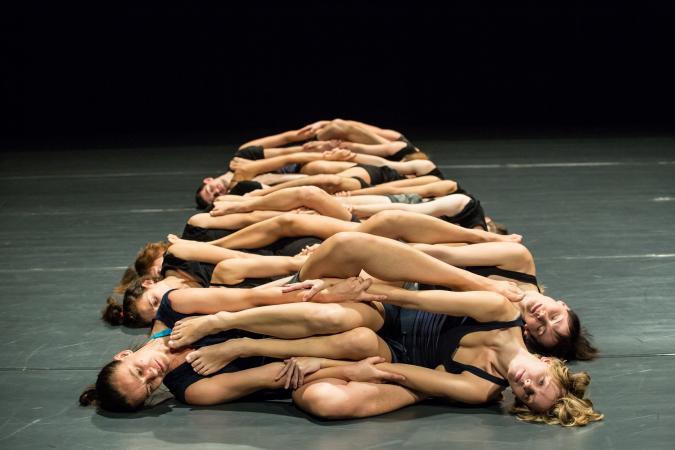
Photo: Jakub Wittchen
As part of the CoFestival in Ljubljana Isabelle Schad and a group of Polish dancers will present Collective Jumps on December 1st 2016 at 8 p.m. at the Kino Šiška (Trg prekomorskih brigad 3). Collective Jumps, a mass choreography of German choreographer Isabelle Schad, touches upon the creation of a community in the process of dance. Various forms and practices stemming from different cultures, and folk and collective traditions, are inspected in the context of contemporary politics of work and body in dance. The piece approaches dance as a political act, and the body as a place of resistance. Analogies with contemporary ?occupy? movements or protest dance (e.g. the Turkish Halay, performed in a huge circle during demonstrations) are evident. Collective Dance is an original protest dance, oscillating between defiance, trance and sensuality; between form, dispersion and abstraction.
Isabelle Schad on reading Hannah Arendt?s On Revolution:
?The group?s body is made out of many. We exercise practices that have the potential to unite instead of individualize. We understand these practices as a relationship to oneself and to one another, as a pathway. These practices are biological ones, cellular ones, energetic ones. We look at freedom in relation to form: form made of and found by an inner process and its rhythm. We experience a multiplicity, manifoldness, subjectivity, and diversity. Even if the form is specific and identical to everyone, it entails a multiplicity within a cycle of repetitions. We look at freedom that is guaranteed once everyone within a group can find form in a subjective way. Therefore, there is a specific relation to the term equality: Everyone can be equal, once subjectivity in one?s own respective rhythm is guaranteed within the form.
?We look for equality in movement and for the end of hierarchy between body parts. Relations between body parts are like relations between people within the group. We play and distort in any kind of way. We differentiate synchronicity from synchronization. We understand synchronicity as the moment when things fall together in time, a phenomenon of energy. We borrow floor, formation, and holding patterns from other communally practiced forms, such as folk dance or Eastern body practices. We relate resistance to questions of rhythm. We relate protest to questions of organization and exercise. We look at the aesthetics of representation and the kind we are trying to resist. We look at the aesthetics of representation as a political practice. Could the creation of an infinite, unified, monstrous body possibly become a site of resistance? Could the body itself become a site of resistance, the body of a dancer ? We examine freedom within a group ? it is ensured provided that every member of the group discovers form in their own, subjective way.?
concept and choreography: Isabelle Schad in collaboration with Laurent Goldring
assistant choreographer: Na?ma Ferré
starring: Magdalena Bartczak, Sonia Borkowicz, Barbara Bujakowska, Halina Chmielarz, Paulina Grochowska, Magda Jędra, Aniela Kokosza, Irena Lipinska, Jakub Margosiak, Dorota Michalak, Gosia Mielech, Janusz Orlik, Marta Romaszkan, Iza Szostak, Krystyna Szydłowska, Natalia Wilk, Ula Zerek
sound / composition: Patryk Lichota
lighting design: Łukasz Kędzierski
co-ordinator: Marta Harasimowicz
produced by: Art Stations Foundation by Grażyna Kulczyk
co-produced by: Goethe-Institut in Warsaw
premiere: 13 and 14 December 2014
duration: 60 min.
Isabelle Schad is a Berlin-based choreographer. Presented all over the world, her performances are a result of bodily explorations (mainly based on Body-Mind Centering practice) as well as research on bodily representation processes. The projects tend to interface dance, performance and visual arts. Isebelle Shad?s meeting with Laurent Golring, a visual artist and photographer, has been important for her work, too. Since 2009 they have put out a series of performances titled Unturtled(s). Isabelle has participated in multiple artistic collectives (Good Work, Praticable). As a teacher and choreographer she works with the Berlin HZT college, with her workshops scattered all around the globe (in March 2010 she lectured at the Alternative Dance Academy). Currently, the artist co-creates the Wiesenburg-Halle creative space in Berlin, at the same time studying and practicing Zen Shiatsu.
Supported by:

More on the CoFestival 2016 in Lublana: www.cofestival.si